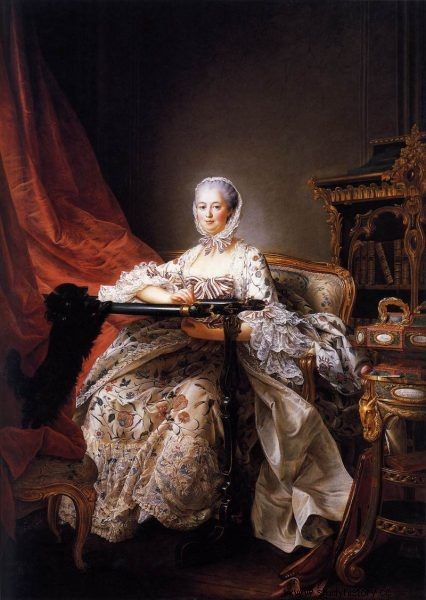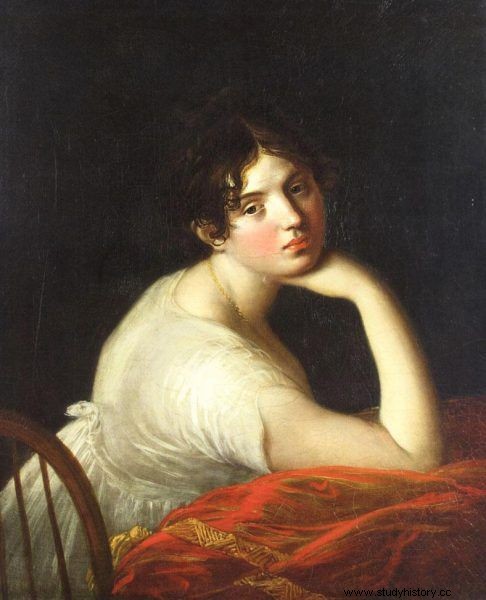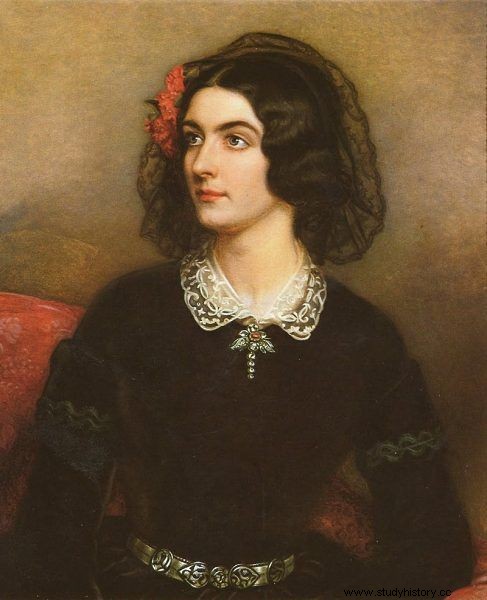At a time when Europe was ruled by kings and emperors, young aristocrats dreamed of becoming lovers of monarchs. It was a more prestigious role than becoming a lawful spouse. Here are the 3 most influential favorites ever.
First, the mistress had an unconditional feeling. The wife, who was most often married for dynastic reasons, could not count on this privilege, and was treated as a belly to give birth to the heir to the throne ...
The favorites were licked up and pampered. They also could count on generous gifts from their lovers; the relatives of these women received honorable and well-paid court positions. It is not uncommon for moles left in history, while wives were forgotten.
Madame de Pompadour - uncrowned queen
Madame de Pompadour (1721-1764) was the first woman to be given the title of maîtresse-en-titre, the official mistress of the king. This relationship lasted about 20 years, but Louis XV and his friend only slept for a few years. After the sexual relationship ceased, the woman remained with the monarch as his most trusted advisor.
The future favorite was born Jeanne-Antoinette Poisson and was famous for her beauty as a child. One day her mother went to a fortune teller who predicted that in the future the girl would win the heart of the king of France. From that moment on, the mother began to do everything possible to ensure that her daughter gained a good education and social manners.

Portrait of the Marquis by François-Hubert Drouais
At 19, Jeanne-Antoinette was married to Charles-William Le Normant d'Étiolles. The spouses ran one of the most famous salons in Paris. The news of the intelligent and beautiful Madame Le Normant d'Étiolles reached Louis XV, who was married to Maria Leszczyńska. The king met Jeanne-Antoinette at a masquerade ball at Versailles. After a month she became his mistress and moved to the royal palace. Jeanne-Antoinette and her husband separated soon. Louis XV gave his métress the title of Marquise de Pompadour.
The new favorite organized lavish parties and theatrical performances for the king. At court - thanks to her friendly disposition - she made more friends than enemies. Even the betrayed Maria Leszczyńska treated her favorably. The lover had two miscarriages, after which the sexual relationship between her and the king ceased.
Paradoxically, it was then that the period of Jeanne-Antoinette's greatest influence began. The woman began to support people of art, she became the patron of many cultural and scientific projects, incl. with her participation, Diderot's "Encyclopedia" was published. She participated in the design of the Place de la Concorde and advised Louis XV on domestic and foreign policy.
Maria Światopełk-Czetwertyńska - Polish woman at the side of the Tsar
For 15 years, this Polish noblewoman (1779-1854) reigned supreme in the heart of Emperor Alexander I. When matters of state importance required the tsar's attention, officials looked for him not in their own home, but in the Polish woman's palace.
Alexander I was married to Elizabeth, née Eliza Baden. Soon after the wedding, Romanov began to cheat on his wife and changed mistresses like gloves. He settled down when the beautiful Maria Naryshkin, née Sviatopełk-Czetwertyńska, better known in Russia as Maria Antonovna, appeared in his life. Her father was Antoni, a member of the Sejm of Partition, marshal of the Targowica confederation, supporter of the so-called Russian option.
Maria, her sister Żaneta and brother Borys appeared in Petersburg after the Kościuszko Uprising, during which their father was hanged without trial by the Warsaw crowd. Catherine II appointed the girls to the court ladies. And then she married Maria to Dmitri Naryshkin, her official, descended from an old boyar family and owned as many as 25,000 serfs.
Court officials, diplomats and ministers used to visit the Naryshkin salon. The spouses were able to entertain the capital's society with intelligent conversation, the best drinks and the most exquisite dishes. Maria was considered one of the most beautiful women in St. Petersburg, therefore she had many lovers. In 1801, among them was 24-year-old Alexander I.
Due to the romance of the Tsar and a Polish woman, Poles living in St. Petersburg began to delude themselves that their compatriot would favor the rebirth of independent Poland. Bitter disappointment awaited them because Mrs. Naryshkin did not get involved in politics. She, of course, had an influence on Alexander, but she used it only in matters of protection of individual members of the St. Petersburg society. The monarch always took her opinion into account, among others. when nominating ministers or other high-ranking officials.

The Russian tsar fell in love with beautiful Poland.
The feeling absorbed the emperor completely. Alexander I forgave Maria even for her many betrayals. Foreign diplomats tried to involve the Polish woman in their political intrigues in order to influence Alexander I through his mistress. Napoleon made such attempts after signing the peace treaty in Tylża, sending his aide as an ambassador to St. Petersburg and ordering him to find access to Maria's house.
Over time, in the court and social circles of St. Petersburg, the Polish woman began to be perceived as the "more important" woman in the Emperor's life. Court painters created allegorical paintings depicting Maria and Alexander. At all unofficial parties, the ruler appeared in the company of a Polish woman, he introduced her as his wife, so the mistress was honored as if she were the empress .
The idyll ended in 1814, just before the Congress of Vienna. Lady Naryshkin unexpectedly left Alexander and went abroad, accompanied by a new lover. After the breakup, the emperor suffered a long time, not even enjoying his political successes.
Lola Montez - the one who brought down the king of Bavaria
Lola Montez (1821-1861) had two professions - dancers, nota bene bad, and scandalous. She was born Maria Dolores Eliza Rosanna Gilbert and was of Irish descent. She did not want to spend her life as an exemplary wife and mother, so she went to Spain to learn the local dances. At the same time, she was learning the language, acquiring Spanish customs and developing an intriguing accent.
In 1843 she came to London as Lola Montez. She had several made-up biographies available. She once told of being kidnapped from her cradle by a gang of Andalusian Gypsies, from whom she learned to sing and dance. Another time she was a widow of a hiddig for whom times were not easy.
Lola's dream was to engage in the Her Majesty's Theater. She fulfilled it after making a close acquaintance with the Earl of Malmesbury, who had considerable influence in this institution. Soon she began performing on European stages. She caused scandals wherever she appeared. For example, in Baden-Baden, she publicly demonstrated her supple body by throwing her leg over the shoulder of a young man. Then the scandalized mayor demanded that she leave the city immediately. A little later, she stole Franz Liszt from his mistress, Countess d'Angoult. Apparently there was a duel between the ladies for ... sharp nails.

Lola Montez made a remarkable career and ... destroyed someone else's
But the culmination of Lola's love conquests was the romance with the King of Bavaria, Louis I. As the fame of the scandalous dancer reached Munich, the director of the local theater refused to sign a contract with Montez. Then Lola went to the king, who stared at her prominent breasts and asked, "A work of nature or an artist?" "This is what Your Majesty has to decide for yourself," she retorted, and, grabbing the scissors lying on the desk, she slit open the gowns even deeper. From that moment on, she was engaged in the theater and King Lola's heart was in her pocket.
Louis I was married and often had fleeting affairs, after which he returned to his wife. This time, the monarch fell head over heels in love with Montez. The dancer fulfilled all his intimate fantasies, the greatest of which was licking and sucking on her unwashed toes. Louis I set her a high annual salary, which he doubled at the end of the first year they spent together. The influence of the dancer was also related to political matters. When Lola became averse to the minister of religion and then to the prime minister, the king first dismissed them and then threw them out of the country. Montez allowed herself to spit in the bishop's face and beat the servants.
The discontent of the Bavarians reached its zenith when Louis I granted her citizenship and two noble titles. Hatred for Lola spread over the country and the king was forced to abdicate. Montez fled Bavaria. Interestingly, Louis I paid his mistress a salary until her death in 1861 and he had no grudge against her for his fall.
